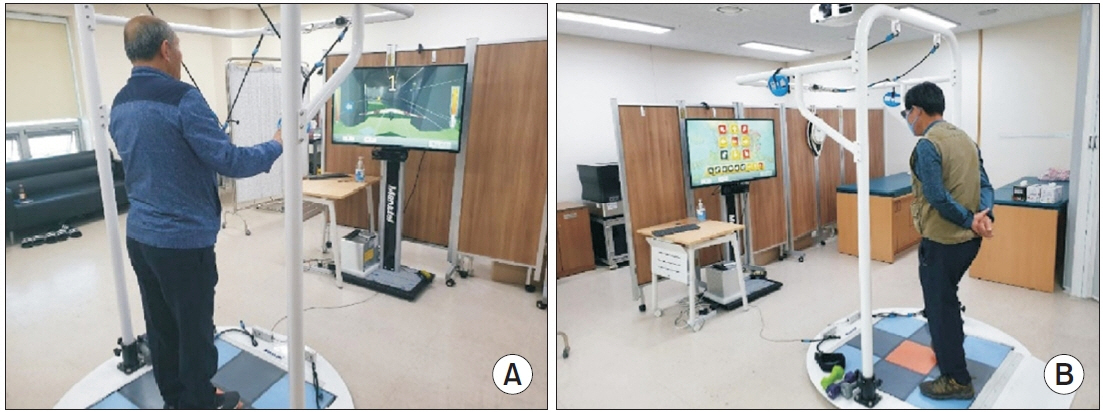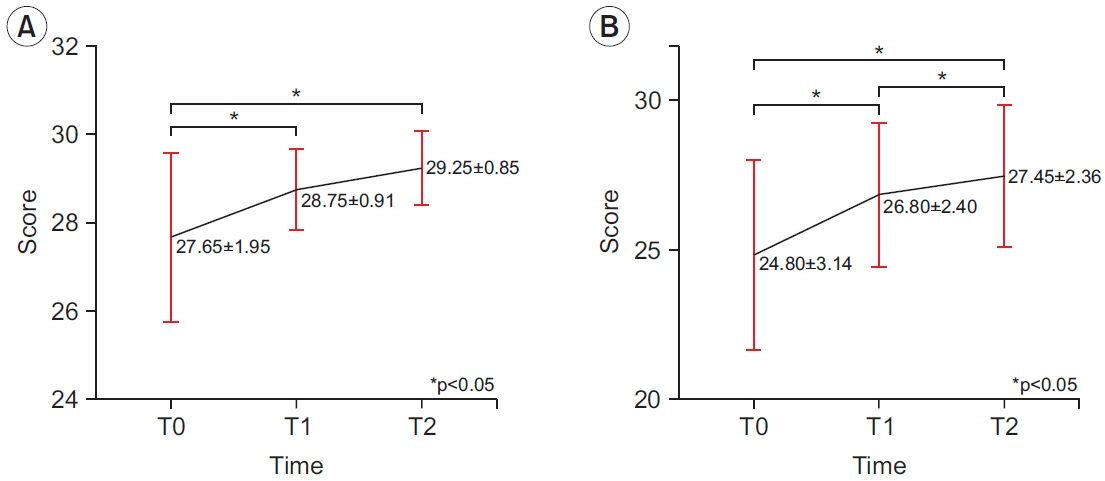Ann Rehabil Med.
2021 Aug;45(4):314-324. 10.5535/arm.21072.
Efficacy of an Integrated Training Device in Improving Muscle Strength, Balance, and Cognitive Ability in Older Adults
- Affiliations
-
- 1Department of Physical Medicine and Rehabilitation, Jeonbuk National University Medical School, Jeonju, Korea
- 2Research Institute of Clinical Medicine of Jeonbuk National University–Biomedical Research Institute of Jeonbuk National University Hospital, Jeonju, Korea
- 3Translational Research & Clinical Trial Center for Medical Device, Jeonbuk National University Hospital, Jeonju, Korea
- KMID: 2519638
- DOI: http://doi.org/10.5535/arm.21072
Abstract
Objective
To determine the effects of an integrated training device for strength and balance on extremity muscle strength, postural balance, and cognition in older adults using a combination with various rehabilitation training games, in which balance, strength, and cognitive training were configured in a single device.
Methods
This prospective study included 20 healthy participants aged 65–85 years. Participants trained for 30 minutes daily, 3 days weekly, for 6 weeks with an integrated training device for strength and balance (SBT-120; Man&Tel Inc., Gumi, Korea). Main outcomes were measured using the Korean Mini-Mental State Examination (K-MMSE), Korean version of the Montreal Cognitive Assessment (K-MoCA), Timed Up and Go Test (TUG), Functional Reach Test (FRT), Berg Balance Scale (BBS), and Manual Muscle Test. Measurements were taken at three time points: T0 (pretreatment), T1 (immediately after treatment), and T2 (4 weeks after treatment).
Results
All 20 patients completed the training, and TUG, FRT, and BBS scores significantly improved at T1 and T2 compared to T0. Mean TUG scores decreased by 0.99±2.00 at T1 and 1.05±1.55 at T2 compared to T0. Mean FRT scores increased by 6.13±4.26 at T1 and 6.75±4.79 at T2 compared to T0. BBS scores increased by 0.60±0.94 at T1 and 0.45±1.15 at T2 compared to T0. Moreover, muscle strength and cognition (K-MMSE and K-MoCA scores) increased after training.
Conclusion
Our findings suggest that an integrated training device for strength and balance can be a safe and useful tool for older adults.
Figure
Reference
-
1. Cohen H, Blatchly CA, Gombash LL. A study of the clinical test of sensory interaction and balance. Phys Ther. 1993; 73:346–54.
Article2. Horak FB, Shupert CL, Mirka A. Components of postural dyscontrol in the elderly: a review. Neurobiol Aging. 1989; 10:727–38.
Article3. Brooks VB. How does the limbic system assist motor learning? A limbic comparator hypothesis. Brain Behav Evol. 1986; 29:29–53.
Article4. Lord SR, Clark RD, Webster IW. Postural stability and associated physiological factors in a population of aged persons. J Gerontol. 1991; 46:M69–76.
Article5. Tinetti ME, Speechley M, Ginter SF. Risk factors for falls among elderly persons living in the community. N Engl J Med. 1988; 319:1701–7.
Article6. Meldrum D, Glennon A, Herdman S, Murray D, McConn-Walsh R. Virtual reality rehabilitation of balance: assessment of the usability of the Nintendo Wii Fit Plus. Disabil Rehabil Assist Technol. 2012; 7:205–10.7. VR Ayoub LC Edelman . Adjustable tension device for use with a resistance band exercise apparatus. United States patent US 10,821,314. 2020. Nov. 3.8. Matjacic Z, Johannesen IL, Sinkjaer T. A multipurpose rehabilitation frame: a novel apparatus for balance training during standing of neurologically impaired individuals. J Rehabil Res Dev. 2000; 37:681–91.9. Cress ME, Buchner DM, Prohaska T, Rimmer J, Brown M, Macera C, et al. Best practices for physical activity programs and behavior counseling in older adult populations. J Aging Phys Act. 2005; 13:61–74.
Article10. Nied RJ, Franklin B. Promoting and prescribing exercise for the elderly. Am Fam Physician. 2002; 65:419–26.11. American College of Sports Medicine. ACSM’s guidelines for exercise testing and prescription. 9th ed. Philadelphia, PA: Lippincott Williams & Wilkins;2013.12. Cha EG, Lee EY, Yang JK, Chung GJ, Koh MH, Shin MJ. Efficacy testing of an integrated IT/game training program for community-dwelling older adults: a pilot randomized controlled trial study. J Korean Acad Rehabil Med. 2018; 8:22–33.13. Nakamura Y, Tanaka K, Yabushita N, Sakai T, Shigematsu R. Effects of exercise frequency on functional fitness in older adult women. Arch Gerontol Geriatr. 2007; 44:163–73.
Article14. Jang HY, Lee JH, Lee SM. The analysis on the reliability and validity of Korean-version balance assessment tools. J Korean Soc Phys Med. 2017; 12:139–46.
Article15. Kim JH. Reliability and validity of gait assessment tools for elderly person. J Korean Phys Ther. 2009; 21:41–8.16. Langley FA, Mackintosh SF. Functional balance assessment of older community dwelling adults: a systematic review of the literature. Internet J Allied Health Sci Pract. 2017; 5:13.
Article17. Duncan PW, Weiner DK, Chandler J, Studenski S. Functional reach: a new clinical measure of balance. J Gerontol. 1990; 45:M192–7.
Article18. Kang Y, Park JS, Yu KH, Lee BC. A reliability, validity, and normative study of the Korean-Montreal Cognitive Assessment (K-MoCA) as an instrument for screening of vascular cognitive impairment (VCI). Korean J Clin Psychol. 2009; 28:549–62.19. Sturnieks DL, St George R, Lord SR. Balance disorders in the elderly. Neurophysiol Clin. 2008; 38:467–78.20. Weirich G, Bemben DA, Bemben MG. Predictors of balance in young, middle-aged, and late middle-aged women. J Geriatr Phys Ther. 2010; 33:110–7.21. Ryushi T, Kumagai K, Hayase H, Abe T, Shibuya K, Ono A. Effect of resistive knee extension training on postural control measures in middle aged and elderly persons. J Physiol Anthropol Appl Human Sci. 2000; 19:143–9.
Article22. Gillespie LD, Gillespie WJ, Robertson MC, Lamb SE, Cumming RG, Rowe BH. Interventions for preventing falls in elderly people. Cochrane Database Syst Rev. 2003; (4):CD000340.
Article23. McCurdy K, Langford G. Comparison of unilateral squat strength between the dominant and nondominant leg in men and women. J Sports Sci Med. 2005; 4:153–9.24. Guimaraes JM, Farinatti PD. Descriptive analysis of variables theoretically associated to the risk of falls in elder women. Revista Brasileira de Medicina do Esporte. 2005; 11:299–305.25. Blair SN, Dunn AL, Marcus BH, Carpenter RA, Jaret P. Active living every day. 2nd ed. Champaign, IL: Human Kinetics;2011.26. Optale G, Urgesi C, Busato V, Marin S, Piron L, Priftis K, et al. Controlling memory impairment in elderly adults using virtual reality memory training: a randomized controlled pilot study. Neurorehabil Neural Repair. 2010; 24:348–57.
Article27. Barnes JN. Exercise, cognitive function, and aging. Adv Physiol Educ. 2015; 39:55–62.
Article28. Taaffe DR, Irie F, Masaki KH, Abbott RD, Petrovitch H, Ross GW, et al. Physical activity, physical function, and incident dementia in elderly men: the Honolulu-Asia Aging Study. J Gerontol A Biol Sci Med Sci. 2008; 63:529–35.
Article29. Lai CH, Peng CW, Chen YL, Huang CP, Hsiao YL, Chen SC. Effects of interactive video-game based system exercise on the balance of the elderly. Gait Posture. 2013; 37:511–5.
Article30. Chang KV, Hsu TH, Wu WT, Huang KC, Han DS. Association between sarcopenia and cognitive impairment: a systematic review and meta-analysis. J Am Med Dir Assoc. 2016; 17:1164.e7–1164.e15.
Article31. Yeung SS, Reijnierse EM, Pham VK, Trappenburg MC, Lim WK, Meskers CG, et al. Sarcopenia and its association with falls and fractures in older adults: a systematic review and meta-analysis. J Cachexia Sarcopenia Muscle. 2019; 10:485–500.
Article32. Sveistrup H. Motor rehabilitation using virtual reality. J Neuroeng Rehabil. 2004; 1:10.33. Lopes JS, Machado AF, Micheletti JK, de Almeida AC, Cavina AP, Pastre CM. Effects of training with elastic resistance versus conventional resistance on muscular strength: a systematic review and meta-analysis. SAGE Open Med. 2019; 7:2050312119831116.
Article34. de Bruin ED, Schoene D, Pichierri G, Smith ST. Use of virtual reality technique for the training of motor control in the elderly: some theoretical considerations. Z Gerontol Geriatr. 2010; 43:229–34.35. Li F, Harmer P, Fisher KJ, McAuley E, Chaumeton N, Eckstrom E, et al. Tai Chi and fall reductions in older adults: a randomized controlled trial. J Gerontol A Biol Sci Med Sci. 2005; 60:187–94.
Article36. Chang JY, Tsai PF, Beck C, Hagen JL, Huff DC, Anand KJ, et al. The effect of tai chi on cognition in elders with cognitive impairment. Medsurg Nurs. 2011; 20:63–9.37. Kawanabe K, Kawashima A, Sashimoto I, Takeda T, Sato Y, Iwamoto J. Effect of whole-body vibration exercise and muscle strengthening, balance, and walking exercises on walking ability in the elderly. Keio J Med. 2007; 56:28–33.
Article38. Chulvi-Medrano I, Colado JC, Pablos C, Naclerio F, Garcia-Masso X. A lower-limb training program to improve balance in healthy elderly women using the Tbow device. Phys Sportsmed. 2009; 37:127–35.
Article39. Ogaya S, Ikezoe T, Soda N, Ichihashi N. Effects of balance training using wobble boards in the elderly. J Strength Cond Res. 2011; 25:2616–22.
Article40. Delbroek T, Vermeylen W, Spildooren J. The effect of cognitive-motor dual task training with the biorescue force platform on cognition, balance and dual task performance in institutionalized older adults: a randomized controlled trial. J Phys Ther Sci. 2017; 29:1137–43.
Article
- Full Text Links
- Actions
-
Cited
- CITED
-
- Close
- Share
- Similar articles
-
- Effect of Cryotherapy on Muscle Strength and Balance on the Ankle Joint in Patients with Stroke
- Relationships among Lower Extremity Muscle Circumference, Proprioception, ROM, Muscle Strength, and Balance Control Ability in Young Adults
- Integrated Effects of Thai Essential Oil and Balance Exercise on Parameters associated with Falls in Older Adults at Risk of Falling: A Randomized Controlled Study
- Cross-education Effects of Muscle Strength and Balance on Unilateral Isokinetic Exercise in Ankle
- Effects of Trunk Control Rehabilitation Robot Training on Dynamic Balance, Lower Extremity Strength, Gait Ability and Pain in Bipolar Hemiarthroplasty




